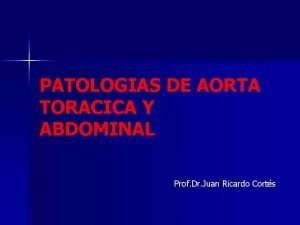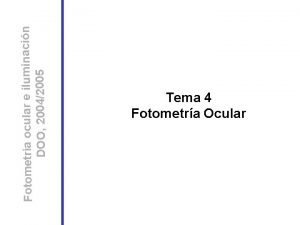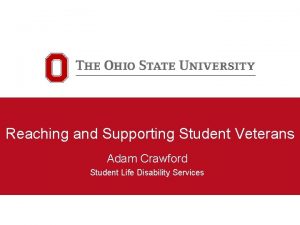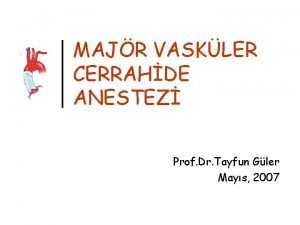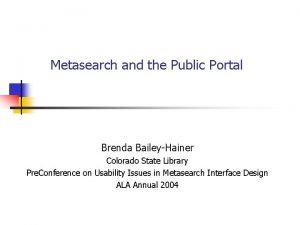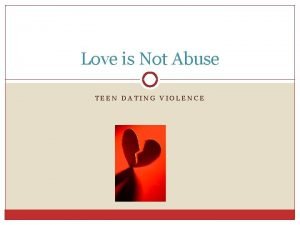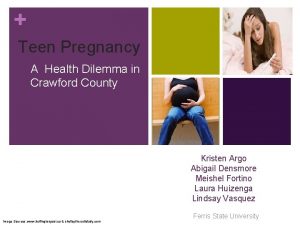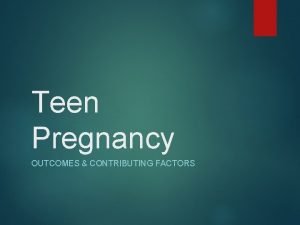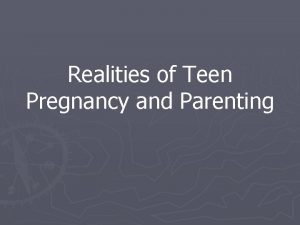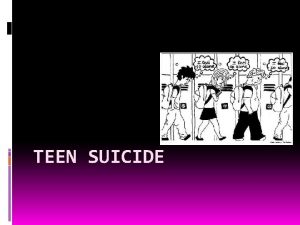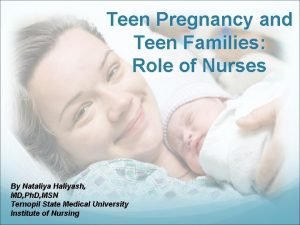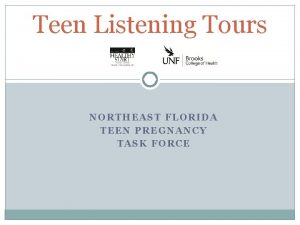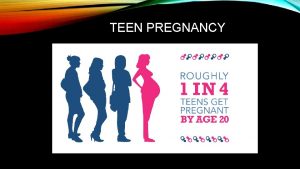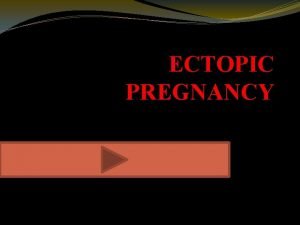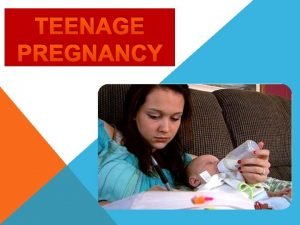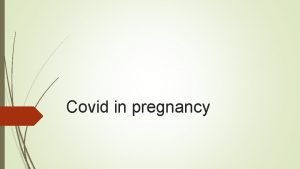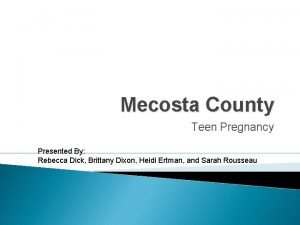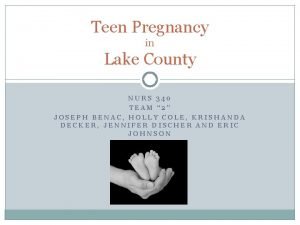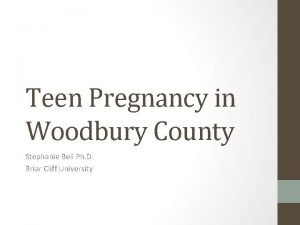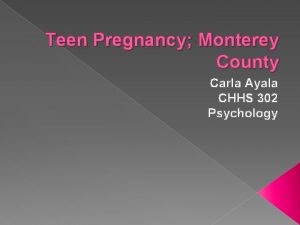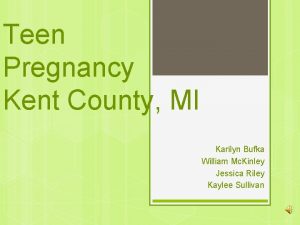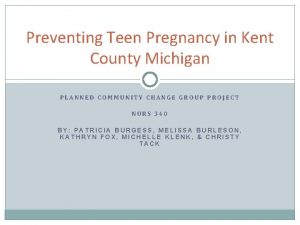Teen Pregnancy A Health Dilemma in Crawford County





































- Slides: 37

+ Teen Pregnancy A Health Dilemma in Crawford County Kristen Argo Abigail Densmore Meishel Fortino Laura Huizenga Lindsay Vasquez Image Sources: www. huffingtonpost. ca & shelleytheradiolady. com Ferris State University

+ Is There a Teen Pregnancy Epidemic? n Across the country teen pregnancy rates are plummeting. In fact, the latest data from the Centers for Disease Control and Prevention reported record lows in teen pregnancy rates nationally. “In 2012, a total of 305, 388 babies were born to women aged 15– 19 years, for a live birth rate of 29. 4 per 1, 000 women in this age group. 1 This is a record low for U. S. teens in this age group, and a drop of 6% from 2011. While reasons for the declines are not clear, teens seem to be less sexually active, and more of those who are sexually active seem to be using birth control than in previous years” (Centers for Disease Control and Prevention, 2014). n These numbers are actually so low that it meets and exceeds the Healthy People 2020 goal of 36. 2 teen pregnancies per 1, 000 (U. S. Department of Health and Human Services, 2014).

+ So…How Does Crawford County Measure Up? Teen Pregnancy Rates per 1, 000 Pregnancies # of Teen Pregnancies 70 60 64. 8 5653. 6 50 61. 1 49. 348. 3 Crawford County 40 31. 3 DHD #10 29. 4 30 Michigan United States 20 10 0 2011 2012 2013 Data compiled from the Michigan Department of Community Health and the Centers for Disease Control and Prevention.

+ Community Nursing Diagnosis n Deficient Knowledge: Pregnancy Prevention related to lack of information regarding birth control methods and resources available to sexually active teenagers in Crawford County. n Community nursing interventions could include the following: n Observe the population and their readiness to learn n Assess the culture, finances and resources available n Use approaches that support the population and their choices n Provide information to support those choices n Include all community resources to help educate teenagers including schools, parents, community programs and spiritual outlets (Ladwig & Ackley, 2008)

+ What Factors are Contributing to this Trend? n Local resources n n The closest Planned Parenthood is located in Traverse City, nearly an hour away from the county n Many teenagers do not own their own car making it difficult to utilize the center n The fear of punishment regarding sexual activity deters most teens from asking for parental assistance The Crawford County Health Department is located in Grayling, MI with operation hours from 8 a. m. - 4: 30 p. m. n These hours coincide with school hours- minors requiring information or assistance regarding pregnancy would need adult permission to miss school

+ What Factors are Contributing to this Trend? n Teen Activities n Crawford County is an extremely rural area with few organized after school activities. n Future Farmers of America (FFA) and 4 H are available through the Michigan State University Extension (MSUE) office (MSUE, 2014). n There are numerous trails, state parks and rivers in Crawford County. Hiking, kayaking and camping are major interests which teens can participate in without being supervised. n Many of the attractions in Grayling, the hub of Crawford County, are focused on adult entertainment. Restaurants, bars and hotels make up the majority of the downtown area.

+ What Concept, Model, or Theory Might Explain the Difference? n The teen pregnancy rates in Crawford County could be explained by the poverty levels experienced in this county compared to the rest of the state n Females between the ages of 15 -19 women who are living in poverty make up a large portion of this population. 27% of this demographic lives in poverty compared to 24% for the state of Michigan overall (District Health Department, 2014). n The median household income in Crawford County is $39, 982 compared to the state average of $48, 471 (District Health Department, 2014).

+ Relevant Change Module (Theories Related to Changing Behavior) n Social Learning Module n n n Behavior change approach affected by environmental influences, personal factors and attributes of the behavior itself. A person must believe in his/her capability to perform the behavior (abstinence/birth control) as well as understand an incentive to do so (no pregnancy). Health Belief Module n n Uses cues as an important way to remind people of healthy behaviors and promote them (ie. anti-pregnancy ads). Dependent on: n n n The severity of illness or physical change (pregnancy) The level of possible vulnerability (high in Crawford County) The benefits of taking preventative action (non-pregnancy) What stands in the way of taking action toward the health promotion goal? Transtheoretical Model n n A sequential approach to behavior change that involves apt readiness for the learner. Five-stage process that people, families and communities move through not in a linear fashion but in a back and forth manner (precontemplation, preparation, action, maintenance).

+ What Groups are Particularly Affected by this Problem? n Females between the ages of 15 and 19 n Females that lack a high school degree n Females living at or below the poverty level

+ Prevention n Primary Prevention: n Secondary Prevention: n Focuses on preventing the condition within the population (Cutler, 2014). n Focuses on preventing spread of the condition within the population (Cutler, 2014). n Primary prevention towards teen pregnancy is focused on educating young women and men about the risks of teen pregnancy. n n The goal is to prevent teen pregnancy within the population Secondary prevention towards teen pregnancy is focused on educating the population about ways to prevent other teen pregnancies. n The goal is to prevent teen mothers from having more teen pregnancies.

+ Education n According to Harkness and De. Marco (2012), 42. 8% of females and 26. 4% males reported having discussions of sexual behavior that included content about teen pregnancy and STIs. This means there was a missed opportunity to educate and spread awareness about teen pregnancy. n Teen mothers account for 13% of all births annually. Preterm birth, low birth weight, child abuse, neglect, poverty, and premature death are all associated with teenage pregnancy (Harkness & De. Marco, 2012, p. 441 -442). There is a higher infant mortality rate in children of teen mothers than other children. n Funding projects for states around the country have been put into place to help decrease the amount of teen moms. More than 75% of teen moms receive public assistance and are more likely to live in poverty (Harkness & De. Marco, 2012, p. 441 -442).

+ Prevention n Harkness and De. Marco wrote in 2012 about how programs that promote abstinence have been proven through evidence to be the most successful. This is mostly a form of primary prevention, it is aimed at educating youth to choose abstinence. However, it can also be considered secondary prevention, even if a member of youth has sex they can still chose to stop and continue to use abstinence as their form of birth control. n Other programs have worked, although not as successfully, at promoting other sources of protection, which can be considered a secondary form of prevention. n For the targeted population we are dealing with youth who have already been sexually active and who might not chose abstinence for the same reason they did chose it originally. However, through secondary prevention programs have been developed using state funding to help spread safe sex and protections methods other than abstinence.

+ Evidence Based Practice n Further education is the best practice to help decrease teen pregnancy. Nurses, parents and educators must ensure that teenagers have the resources necessary to make smart decisions about pregnancy prevention. n “There is a strong association between teenage pregnancy and child well-being. Morbidity associated with children of teenage pregnancy includes pre-term birth, low birth weight, child abuse, neglect, poverty and premature death” (Harkness & De. Marco, 2012, p. 441). n Educating teens who are pregnant and young mothers about child birthing classes and child care classes decreases the possibility of these issues.

+ What Existing Resources are Available to Address this Problem? n District Health Department #10 n Located in Grayling, center of Crawford County n Family planning services are offered mornings, afternoons and early evenings n Services available to men and women of all ages, including teens n Parental consent is not required n Sliding fee scale n No one is denied service due to inability to pay n Medicaid accepted n Clinics staffed by nurse practitioner and/or nurse midwife

+ Resources Available n Health Education is offered at Crawford County Public Schools n n Grades kindergarten through high school Topics include (age/grade appropriate): n HIV/AIDS n Puberty n Reproduction n Relationships/feelings/respect n Abstinence n Protection/Prevention

+ Resources Available The nearest Planned Parenthood is about 50 miles away in Traverse City. This is approximately a 1 hour drive.

+ Disciplines that Should be Involved in Addressing Teen Pregnancy n. Social Work n. Teachers/ Educators

+ Is this Enough? No. In 2013, the rate for teen pregnancy in Crawford County (61. 1) is higher than the rates in DHD#10 (56. 0) and Michigan (53. 6) (Rate per 1, 000 females ages 15 -19)

+ Social Work n Counseling by trained professionals can be pivotal in deterring teen pregnancy. n Social workers can help teens work through all aspects of their lives in order to discoverall well-being. This will also improve confidence and decrease the risk of teen pregnancy. n By having social workers available at all the DHD#10 offices, teens have readily available resources. n Becoming a pregnant teen is due to multiple factors. For example, “Teenagers' choices to become sexually active and to use contraception, as well as their ability to obtain and use contraception if this choice is made, are influenced by many factors. These factors operate at the individual level (e. g. , knowledge, attitudes and beliefs, future expectations, substance use), the interfamilial level (e. g. , family structure, parent–child communication, socioeconomic status), the extrafamilial level (e. g. , peer influences, sexual health education at school, health services) and the community level (e. g. , norms and values concerning teenage pregnancy)” (Langille, 2007). Social workers can determine what a teen needs holistically.

+ Teachers & Educators n Adolescents spend a majority of their youth in the presence of teachers and educators. In fact, for some youth, this may be the only place they receive positive influence. n “School-based programs are the primary means by which prevention curricula are delivered to young people and are now required in more than 85% of the schools in the United States”(La. Chausse, Clark, & Chapple, 2014). n Sexual health and education programs can the pivotal factor in decreasing teen pregnancy rates.

+ Teachers & Educators n For example, Grayling High School, located in Crawford County has chosen to implement the Safer Choices program as their curriculum of choice for sexual health education. n The following slide contains their reproductive health course curriculum located on the Grayling Au Sable school site.

+ Crawford Au. Sable School District. (2014).

+ Does the Geopolitical Community Selected Differ from Previous Settings for this Intervention? n Geopolitical Community n n A specific area possessing geographical boundaries and sharing the same governing structure (cities, towns, neighborhoods or locales). Education and resourcing has been beneficial in other settings outside of Crawford County n Teen pregnancy rates (per 1, 000 females) for neighboring counties, Kalkaska and Missaukee decreased while Crawford increased between 2009 and 2013. 2009 2013 Crawford 57. 2 61. 1 Kalkaska 82. 0 54. 4 Missaukee 73. 1 46. 1

+ What Community Groups could be Resources in Addressing the Issue? n Friends n Church Groups n Social Media

+ Permission? n Permission, per se, is not required for community sex/health education. n Many communities set up a committee comprised of educators and parents to discuss what should be taught to the children in school. n Community nurses, if available, should be included in this team. n They have information regarding successful programs, knowledge regarding the community they support and the trust of the teenagers they will assist.

+ Barriers to Success n Poverty : teens that live in poverty, may be more at risk for depression, low-self esteem. n Transportation: many programs are offered to far away for these families with economic difficulties to get to. n Rural areas: many of the teens living in rural areas may not have access to the resources available. n Education: many of these teens may not understand written material that they might gain. n Drug and alcohol use: many teens that are using drug and alcohol may make poor decisions. n Parents: in order for programs to be successful in preventing teen pregnancy, parents need to be involved and supportive.

+ Community Nursing: Helping Decrease the Teen Pregnancy Rate n Programs that involve community nurses and visiting nurses have shown a decrease in teen pregnancy. n Nurses within the community take the time to evaluate how the education about pregnancy prevention and abstinence is being perceived by the teen. n Nurses can help educate teens in different ways of pregnancy prevention to help eliminate birth control failure. n Nurses that can travel, can go to the teen having trouble with transportation. n Nurses that work with teens can evaluate potential issues that can increase their risk for becoming pregnant, and educate the teen about those risks. n Nurses working with their community understand where the needs of that particular community are. They can work with parents to help promote the education the nurses have given their teen.

+ Evidence that Nurses can Help n It has been shown that many programs are focused on abstinence. They do not teach contraceptive use or about STDs and STIs n In communities with nurses assessing and working with pregnant teen nurses, there has been a decline of repeat pregnancies. n Community nurses can assess teens about their sexual health and knowledge of sexual health. They can teach about contraceptive use. n Nurses can teach the risks of smoking while pregnant and give education about smoking cessation

+ School Nurses Role n The National Association of School Nurses feels like school nurses are valuable in watching the trends of teen pregnancy and other education needs for teenagers. They also feel that they are valuable in linking teenagers with valuable resources that they need if they are pregnant, need contraceptive, and need further health care

+ National Campaign to Prevent Teenage Pregnancy The National Campaign to Prevent Teenage Pregnancy is also aware; n Less than half of pregnant teens will graduate from high school and n Children born from teens moms are more likely to have low birth weight, and twice as likely to be abused. n (Minority Nurse, 2014)

+ Community Nurse Programs Community nurses follow teenagers throughout pregnancy to help promote health and smoking cessation during pregnancy. They teach teenagers about birth and parenting. They continue to follow them after the baby is born to help with challenges and education about raising healthy children. They teach about preventing further unplanned pregnancies and help them find resources.

+ Crawford County can benefit from school nursing and community nursing for helping in preventing teenage pregnancy, smoking cessation during pregnancy, and aiding pregnant teenagers to have healthy babies. n Many have transportation issues in this area so community nurses can travel to them to aid with teenage pregnancy health n School nurses can help assess teens and follow them through high school to aid in their changing needs on sexual education.

+ Potential Barriers for Crawford County n The cost for a nurse traveling far my be difficult to fund. If funding is provided it could save many other dollars spent on supporting young parents and their children. They can help promote finishing school, that may help them able to financially support themselves and their children. They can help prevent further pregnancies’; which will make it less difficult for the teenagers to finish their educations and get better jobs. n School nurses have many teenagers to see. They need the support of the parents and teachers to help make sure their interventions are continued.

+ What Other Outcomes Would be Useful? n Process outcomes n n Structural outcomes n n Updated health/sex education programs Fixed health educators/mentors in schools and community centers Measures n Teen mother/father n Child development n Family support n Community support

+ Resources Advocates for Youth. 2008. Safer Choices. Retrieved from http: //www. advocatesforyouth. org/publications/1128? task=view Centers for Disease Control and Prevention. (2014). About Teen Pregnancy: Teen Pregnancy in the United States. Retrieved from http: //www. cdc. gov/teenpregnancy/aboutteenpreg. htm Crawford Au. Sable School District. 2014. Grayling High School Reproductive Health Curriculum. Retrieved from http: //www. casdk 12. net/Stones. Web/Curriculum. Documents/Electives/Physical. E ducation/GHSHealth. Curriculum-MEAD. pdf Cutler, L. (2004). Levels of Prevention. Retrieved from: https: //www. wisconline. com/learn/career-clusters/health-science/nur 3403/levels-of-prevention Davis-Alldritt, L. , Bushmiaer, M. , Desisto, M. , Lambert, P. , Murphy, K. , Roland, R. , et al. (2011, June). Pregnant and Parenting Students, The Role of the School Nurse. Retrieved October 11, 2014, from National Association of School Nurse: http: //www. nasn. org/Policy. Advocacy/Position. Papersand. Reports/NASNPosition Statements. Full. View/tabid/462/smid/824/Article. ID/120/Default. aspx

+ Resources District Health Department. (2014). Crawford County. Health Profile Chartbook 2013. Retrieved from: http: //dhd 10. org/images/Crawford_Chartbook_2013__Feb_18_2014. pdf District Health Department #10. (2013). http: //www. dhd 10. org/ Google Maps. (2014). https: //www. google. com/maps King, L. (2012, June). Community Health Needs Assessment: Improving the Health of the Community. Retrieved October 1, 2014, from Mercy Health Hospital Grayling: http: //www. mercyhealthgrayling. com/documents/Grayling/Mercy%20 Hospital%20 Grayling %20 CHNA. pdf Ladwig, G. & Ackley, B. (2008). Guide to nursing diagnosis (2 nd edition). St. Louis, MO: Mosby-Elsevier. La. Chausse, R. G. , Clark, K. R. , & Chapple, S. (2014). Beyond Teacher Training: The Critical Role of Professional Development in Maintaining Curriculum Fidelity. Journal of Adolescent Health, 54(3), S 53 -S 58. Langille, D. B. (2007). Teenage pregnancy: trends, contributing factors and the physician's role. Canadian Medical Association Journal, 176 (11), 1601 -1602. Michigan State University Extension. 2014. Retrieved from http: //msue. anr. msu. edu/county/info/crawford

+ Resources Olseski, J. (2003, May). Critical Health Indicators. Retrieved October 5, 2014, from Michigan Department of Health: http//www. bhsj. org/healthdata/State. Reports/Critical. Healthindicators. pdf Planned Parenthood. (2014). http: //www. plannedparenthood. org/health-center U. S. Department of Health and Human Services. (2014). Family Planning. Retrieved from http: //www. healthypeople. gov/2020/topicsobjectives/topic/family-planning/objectives Wessling. S. (n. d. ). Turning the Tide: Teen Pregnancy in Minority Communities. Retrieved October 31, 2014, from Minority Nurse. http: //minoritynurse. com/article/turning-tide-teen-pregnancy-minoritycommunitites
 John crawford chris crawford
John crawford chris crawford Welcome to teen challenge uk - teen challenge uk
Welcome to teen challenge uk - teen challenge uk Spotting differential diagnosis
Spotting differential diagnosis Clasificacion de aneurisma de aorta abdominal
Clasificacion de aneurisma de aorta abdominal Merle crawford
Merle crawford Gardeen housing
Gardeen housing Efecto stiles crawford
Efecto stiles crawford Cinema du look
Cinema du look Tim crawford cpa
Tim crawford cpa Glen crawford
Glen crawford Michaela crawford
Michaela crawford John honeycutt uky
John honeycutt uky Adam crawford osu
Adam crawford osu Arcus aorta dalları
Arcus aorta dalları Ashlee crawford
Ashlee crawford Crawford area transportation authority
Crawford area transportation authority Crawford slip writing method
Crawford slip writing method Learning curve equation
Learning curve equation John crawford architect
John crawford architect Chris crawford
Chris crawford Hustead vs tuohy needle
Hustead vs tuohy needle New product management crawford
New product management crawford Maria crawford scott
Maria crawford scott Frank crawford
Frank crawford Crawford and di benedetto
Crawford and di benedetto Lucy crawford
Lucy crawford Jay crawford first take
Jay crawford first take Cindy crawford chemical engineering
Cindy crawford chemical engineering Mia crawford
Mia crawford Nn teens porn
Nn teens porn Explorica teen tours
Explorica teen tours Volumetric efficiency of engine
Volumetric efficiency of engine Concaine bear
Concaine bear Veertig sinkplate teen die suidewind
Veertig sinkplate teen die suidewind Teen nn portal
Teen nn portal Safety plan teen
Safety plan teen Chapter 11 managing weight and eating behaviors
Chapter 11 managing weight and eating behaviors Gauravkumar13
Gauravkumar13



